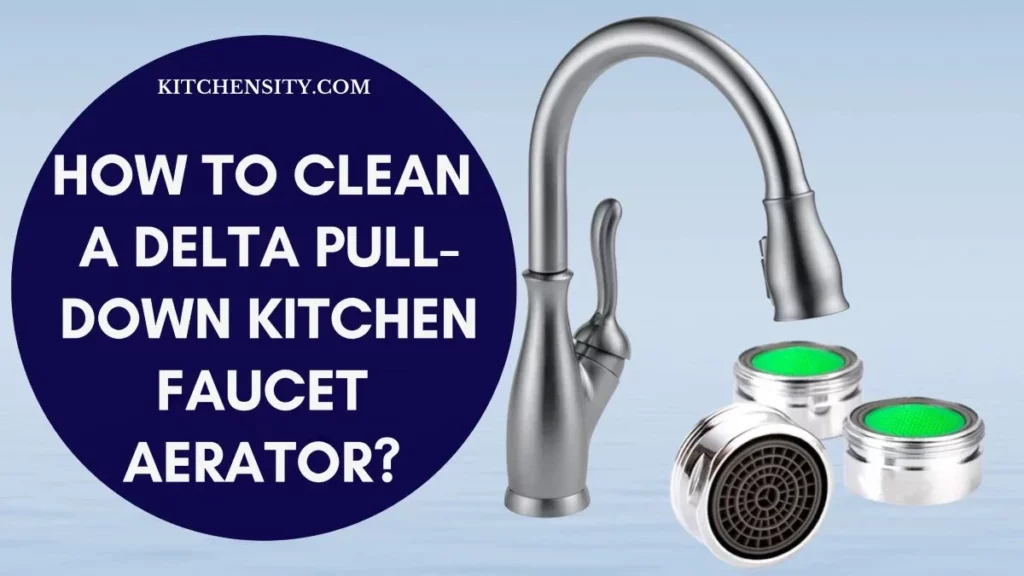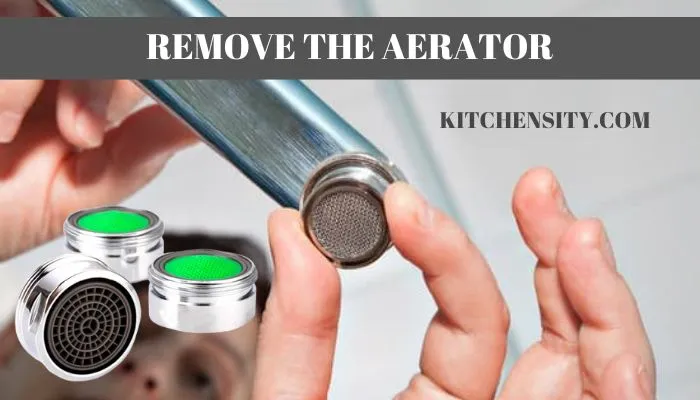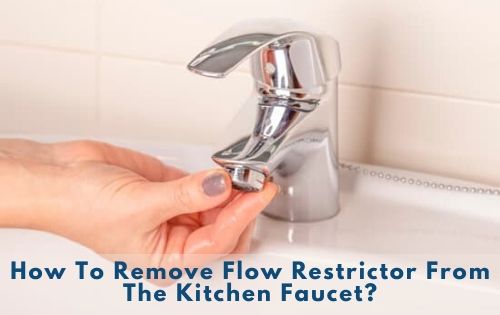Are you tired of dealing with reduced water flow or a spluttering stream from your Delta pull-down kitchen faucet?
The culprit might just be a clogged or dirty aerator.
The aerator plays a vital role in maintaining a smooth water flow and preventing debris from entering your faucet.
In this comprehensive guide, we’ll walk you through the step-by-step process of cleaning a Delta pull-down kitchen faucet aerator.
Say goodbye to low water pressure and hello to a sparkling clean aerator that ensures optimal performance for your kitchen faucet.
Let’s dive in and discover how to bring back the refreshing flow to your Delta pull-down faucet!

Table of Contents
- 1 How To Clean A Delta Pull-Down Kitchen Faucet Aerator?
- 2 Delta Kitchen Faucet Aerator And Its Requirement Of Cleaning
- 3 Tools And Materials Needed
- 4 Step-By-Step Guide On Cleaning The Delta Pull-Down Kitchen Faucet Aerator
- 4.1 Step 1: Turning Off The Water Supply
- 4.2 Step 2: Removing The Aerator From The Faucet
- 4.3 Step 3: Disassembling The Aerator
- 4.4 Step 4: Cleaning The Individual Components
- 4.5 Step 5: Soaking The Aerator In Vinegar Solution
- 4.6 Step 6: Scrubbing The Aerator With A Brush
- 4.7 Step 7: Reassembling The Aerator
- 4.8 Step 8: Attaching The Aerator Back To The Faucet
- 5 Where Is The Flow Restrictor In A Delta Kitchen Faucet?
- 6 Tips For Maintaining A Clean Aerator
- 7 Benefits Of Cleaning the Aerator
- 8 Conclusion
- 9 YOU MAY ALSO LIKE
- 10 FAQs (Frequently Asked Questions)
- 10.1 How Often Should I Clean My Delta Pull-Down Kitchen Faucet Aerator?
- 10.2 How Do I Remove The Aerator From A Delta Pull-Down Faucet?
- 10.3 Do All Faucets Have Removable Aerators?
- 10.4 Can I Use Other Cleaning Solutions Instead Of Vinegar?
- 10.5 Are There Any Specific Precautions I Should Take While Cleaning The Aerator?
- 10.6 What Should I Do If My Aerator Is Damaged Or Cracked?
- 10.7 Which Way Do You Unscrew A Faucet Aerator?
- 10.8 Can I Clean The Aerator Without Removing It From The Faucet?
How To Clean A Delta Pull-Down Kitchen Faucet Aerator?
To clean a Delta pull-down kitchen faucet aerator, follow these steps:
- Turn off the water supply under the sink.
- Unscrew the aerator from the faucet using pliers or an adjustable wrench.
- Disassemble the aerator and remove any visible debris.
- Soak the components in a mixture of equal parts white vinegar and water for 30 minutes.
- Scrub the parts with a toothbrush to remove stubborn deposits.
- Rinse the components thoroughly and reassemble the aerator.
- Screw the aerator back onto the faucet and turn on the water supply.
- Regular cleaning ensures optimal performance and prevents clogs.
Also Read – What Is A Basin Wrench And How To Use It?
Delta Kitchen Faucet Aerator And Its Requirement Of Cleaning
Before diving into the cleaning process, let’s understand what a Delta pull-down kitchen faucet aerator is and why it is essential to keep it clean.
The aerator is a small device attached to the end of the faucet spout. It serves two primary purposes: mixing air with water to reduce splashing and conserving water by maintaining a steady flow rate.
Over time, the aerator can accumulate sediment, hard water deposits, and other impurities that can hinder water flow and affect the faucet’s performance.
By regularly cleaning the aerator, you can ensure a smooth and uninterrupted water flow, prevent clogs, and extend the lifespan of your Delta pull-down kitchen faucet.
Also Read – Best Basin Wrench Alternatives
Tools And Materials Needed
Before you begin cleaning the aerator, gather the following tools and materials:
- Adjustable wrench
- Pliers
- Screwdriver (if necessary)
- Bowl or bucket
- White vinegar
- A toothbrush or small brush
- Clean cloth or towel
In addition to these tools, you may also need common household items like baking soda or a descaling solution depending on the severity of mineral deposits.
Also Read – How To Remove Kitchen Faucet Without Basin Wrench?
Step-By-Step Guide On Cleaning The Delta Pull-Down Kitchen Faucet Aerator
Follow these steps to clean the Delta pull-down kitchen faucet aerator:
Step 1: Turning Off The Water Supply
- To ensure a safe and mess-free cleaning process, locate the water shut-off valves under the sink and turn them off.
- This step will prevent water from flowing while you work on the aerator.
Step 2: Removing The Aerator From The Faucet

To remove the aerator from a Delta pull-down faucet, follow these steps:
- Prepare The Necessary Tools: Grab an adjustable wrench or a pair of pliers. These tools will help you unscrew the aerator effectively.
- Locate The Aerator: Take a look at the end of the faucet spout. The aerator is usually attached there. It may have a small cap or cover, depending on the faucet model.
- Position The Wrench Or Pliers: Place the adjustable wrench or pliers around the aerator, ensuring a firm grip. Make sure the tool is securely positioned to avoid slipping during the removal process.
- Unscrew The Aerator: Rotate the wrench or pliers counterclockwise to loosen the aerator. Apply gentle pressure and maintain a steady grip to prevent any accidental damage to the aerator or faucet.
- Protect The Aerator: To safeguard the aerator from scratches or other potential damage, wrap a soft cloth or towel around it before you start unscrewing. This extra layer of protection will help maintain the aerator’s appearance.
- Continue Unscrewing: Keep turning the wrench or pliers counterclockwise until the aerator is fully detached from the faucet spout. Take your time and ensure a smooth and controlled removal process.
Once the aerator is successfully unscrewed, proceed to the next step of disassembling and cleaning it for optimal performance.
Also Read – Low Water Pressure In The Kitchen Sink: How To Fix It?
Step 3: Disassembling The Aerator
After removing the aerator from the faucet, follow these steps to disassemble it:
- Inspect The Aerator: Take a closer look at the aerator and examine its structure. Notice any visible screws, clips, or other fasteners that hold the components together.
- Determine The Disassembly Method: Depending on the aerator design, it may be possible to disassemble it by hand. In this case, you can simply twist or pull apart the components. However, some aerators may require the use of a screwdriver or pliers to remove screws or loosen fasteners.
- Use Appropriate Tools: If your aerator has screws or fasteners, select the appropriate tool, such as a small screwdriver or pliers, to aid in disassembly. Ensure the tool fits securely in the screw head or fastener to avoid damaging the aerator.
- Disassemble Carefully: Start by loosening or removing the screws or fasteners one by one, following the specific disassembly method for your aerator. Take your time and handle the components gently to prevent any breakage or damage.
- Pay Attention To Component Order: As you disassemble the aerator, observe the order in which the components are arranged. This will make reassembly easier later on. If needed, take note of the sequence or take a picture for reference.
- Separate The Components: Once all screws or fasteners are removed, carefully separate the components of the aerator. Set them aside in an organized manner to ensure they don’t get mixed up or lost.
By disassembling the aerator, you gain access to the individual components, making it easier to clean them thoroughly and remove any accumulated debris or deposits.
Also Read – How To Fix A Faucet Handle That Turns Too Far?
Step 4: Cleaning The Individual Components
To effectively clean each component of the aerator, follow these steps:
- Examine The Components: Take a closer look at each part of the aerator. Check for any visible debris, sediment, or mineral deposits that may have accumulated on the surfaces.
- Wipe Off Visible Debris: Using a clean cloth or towel, gently wipe away any loose debris or deposits from the components. This initial wiping helps remove the larger particles and prepares the components for a more thorough cleaning.
- Address Stubborn Buildup: If you notice stubborn mineral deposits or debris that cannot be easily wiped away, use a toothbrush or a small brush to scrub the affected areas. Dip the brush in water or a cleaning solution to aid in the cleaning process.
- Scrub Gently: With the toothbrush or small brush, scrub the components in a gentle circular motion. Pay attention to areas where buildup is more concentrated, such as mesh screens or openings. Be careful not to apply excessive force that may damage the components.
- Rinse The Components: After scrubbing, rinse each component thoroughly under running water. This will remove any loosened debris or cleaning solution residue.
- Inspect The Cleanliness: Examine the components again to ensure that they are free from debris and mineral deposits. If you notice any remaining buildup, repeat the cleaning process until the components are thoroughly clean.
By cleaning each component of the aerator, you ensure that all parts are free from debris and buildup that could hinder the aerator’s performance.
Once the components are clean, you can proceed to the next step to further clean the aerator as a whole.
You May Also Like: How To Unclog A Sink Clogged With Coffee Grounds?
Step 5: Soaking The Aerator In Vinegar Solution
To effectively clean the disassembled components of the aerator, follow these steps:
- Prepare The Vinegar Solution: In a bowl or bucket, combine equal parts white vinegar and water. This solution will serve as a natural cleaning agent to dissolve mineral deposits and disinfect the aerator.
- Place The Components In The Solution: Take the disassembled components of the aerator and carefully submerge them into the vinegar solution. Ensure that all parts are fully covered by the solution for optimal cleaning.
- Let The Aerator Soak: Allow the components to soak in the vinegar solution for about 30 minutes. During this time, the vinegar will work to break down mineral deposits and remove any lingering debris.
- Ensure Complete Immersion: Occasionally, gently agitate the components in the solution to ensure all surfaces come into contact with the vinegar mixture. This helps to dislodge any stubborn deposits and allows for thorough cleaning.
- Maximize Cleaning Time: For particularly stubborn deposits or extensive buildup, you can extend the soaking time to an hour or two. This extra time will give the vinegar solution more opportunity to dissolve the deposits effectively.
- Use A Lid Or Cover (Optional): If desired, you can place a lid or cover over the bowl or bucket to prevent evaporation of the vinegar solution during the soaking process. This helps maintain the effectiveness of the solution throughout the cleaning duration.
- Ensure Proper Ventilation: While the components are soaking, make sure the area is well-ventilated due to the strong odor of vinegar. Open windows or use a fan if necessary to prevent any discomfort.
The vinegar solution acts as a powerful natural cleaner, breaking down mineral deposits and disinfecting the aerator components.
You May Also Like: 6 Pull Out Spray Kitchen Faucet Problems
Step 6: Scrubbing The Aerator With A Brush
- After the components have soaked, use the toothbrush or small brush to scrub each part thoroughly.
- Pay particular attention to the screen or mesh filter, as it is prone to clogging.
- Remove any remaining debris or deposits.
Step 7: Reassembling The Aerator
- Once all the components are clean and free of debris, reassemble the aerator in the correct order.
- Make sure each part fits securely but avoid overtightening, as it may cause damage.
Step 8: Attaching The Aerator Back To The Faucet
- Carefully screw the cleaned aerator back onto the faucet spout.
- Use the adjustable wrench or pliers to tighten it, ensuring a snug fit.
- Be cautious not to overtighten, as it may damage the aerator or the faucet.
Also Read – How To Lubricate A Swivel Faucet?
Where Is The Flow Restrictor In A Delta Kitchen Faucet?
In a Delta kitchen faucet, the flow restrictor is typically located inside the aerator.
The aerator is the small mesh screen at the end of the faucet spout that helps to control the water flow and prevent splashing.
The flow restrictor is a small component within the aerator that regulates the amount of water that can pass through the faucet.
- To access the flow restrictor, you will need to remove the aerator from the faucet spout.
- Unscrew the aerator using an adjustable wrench or pliers in a counterclockwise direction.
- Once the aerator is removed, you can see the flow restrictor inside. It is usually a small disc or plate with perforations that control the flow of water.
It’s worth noting that the location and design of the flow restrictor may vary slightly depending on the specific Delta kitchen faucet model.
If you’re having trouble locating the flow restrictor or need more specific information, it’s recommended to refer to the manufacturer’s documentation or contact Delta customer support for assistance.
Also Read – How To Fix A Stiff Kitchen Faucet?
Tips For Maintaining A Clean Aerator
To keep your Delta pull-down kitchen faucet aerator in optimal condition, follow these tips:
- Establish A Regular Cleaning Schedule: Set a reminder to clean the aerator every few months or whenever you notice reduced water flow.
- Check For Leaks Or Damage: During the cleaning process, inspect the aerator for any cracks, leaks, or other signs of damage. If necessary, replace it to maintain optimal performance.
- Use A Water Softener If Necessary: If you live in an area with hard water, consider installing a water softener or using a descaling solution regularly. This can prevent mineral buildup and prolong the lifespan of your aerator.
Benefits Of Cleaning the Aerator
Regularly cleaning your Delta pull-down kitchen faucet aerator offers several benefits, including:
- Improved Water Flow: By removing debris and mineral deposits, you can restore the faucet’s original water flow, ensuring a steady and consistent stream.
- Reduction In Water Wastage: A clean aerator allows water to flow freely, minimizing the chances of splashing or wasteful water usage.
- Prevention Of Clogs And Blockages: Cleaning the aerator helps prevent clogs caused by sediment, mineral deposits, or other debris, saving you from the inconvenience of a malfunctioning faucet.
Conclusion
Congratulations! You’ve now learned how to effectively clean a Delta pull-down kitchen faucet aerator.
By following the simple steps outlined in this guide, you can ensure that your aerator remains free from debris, mineral deposits, and buildup that can hinder its performance.
Regular maintenance and cleaning of your aerator will not only restore optimal water flow but also prolong the lifespan of your Delta faucet.
So, the next time you notice reduced water pressure or a compromised stream, don’t fret!
Armed with the knowledge and techniques you’ve gained, you can confidently tackle the task of cleaning your Delta pull-down kitchen faucet aerator.
Enjoy the renewed efficiency and functionality of your faucet, and keep the water flowing smoothly in your kitchen for years to come!
YOU MAY ALSO LIKE
- How To Remove Handle From Faucet?
- How To Fix A Spinning Faucet Handle?
- How To Remove Flow Restrictor From The Kitchen Faucet?
- How To Fix A Leaky Kitchen Faucet?
- Tighten A Loose Moen Single Handle Kitchen Faucet & Base
- How To Remove Flow Restrictor From The Kitchen Faucet?
FAQs (Frequently Asked Questions)
-
How Often Should I Clean My Delta Pull-Down Kitchen Faucet Aerator?
It is recommended to clean the aerator every few months or whenever you notice reduced water flow. Regular cleaning helps maintain optimal performance.
-
How Do I Remove The Aerator From A Delta Pull-Down Faucet?
To remove the aerator from a Delta pull-down faucet, first, locate the aerator at the end of the faucet spout.
Use an adjustable wrench or pliers to grip the aerator firmly, and then turn it counterclockwise (left) to unscrew it from the faucet spout.
Once it is loose, you can continue to unscrew it by hand and remove it completely. -
Do All Faucets Have Removable Aerators?
Not all faucets have removable aerators. While many modern faucets are designed with removable aerators for easy cleaning and maintenance, some older or specialized faucets may not have this feature.
In such cases, the aerator may be integrated into the faucet spout and cannot be unscrewed or removed separately. -
Can I Use Other Cleaning Solutions Instead Of Vinegar?
Yes, you can use descaling solutions or even baking soda mixed with water to clean the aerator. Vinegar is a popular and natural option that works effectively.
-
Are There Any Specific Precautions I Should Take While Cleaning The Aerator?
Ensure that you turn off the water supply before removing the aerator. Additionally, handle the components carefully to avoid damaging them during the cleaning process.
-
What Should I Do If My Aerator Is Damaged Or Cracked?
If you notice any damage or cracks in the aerator, it is best to replace it. Damaged aerators can affect water flow and may lead to leaks or other issues.
-
Which Way Do You Unscrew A Faucet Aerator?
To unscrew a faucet aerator, you typically need to rotate it counterclockwise. This means turning it to the left or in the opposite direction of how you would tighten it.
Using an adjustable wrench or pliers, grip the aerator firmly and rotate it counterclockwise to loosen and remove it from the faucet spout.
Remember to be gentle to avoid damaging the aerator or faucet. -
Can I Clean The Aerator Without Removing It From The Faucet?
While it is recommended to remove the aerator for a thorough cleaning, you can try using a small brush or toothbrush to clean it in place. However, removing the aerator provides better access to clean all the components effectively.
Katrina Smith is a seasoned expert with over 25 years of experience in all things related to cooking and the kitchen. As an avid cook and kitchen enthusiast, she is passionate about sharing her knowledge and expertise on cookware, kitchen appliances, kitchen tips, and kitchen staples.
Through her articles and reviews, Katrina aims to inspire and help others improve their cooking skills, experiment with different ingredients, and invest in quality cookware and appliances.

![How To Unclog A Sink Clogged With Coffee Grounds? [3 Effective Ways] 4 How-to-Unclog-a-Sink-Clogged-With-Coffee-Grounds](https://www.kitchensity.com/wp-content/uploads/2020/06/How-to-Unclog-a-Sink-Clogged-With-Coffee-Grounds.jpg)


![Best Insulation Under The Kitchen Sink [3 Top Insulations] 7 Best Insulation Under The Kitchen Sink](https://www.kitchensity.com/wp-content/uploads/2023/04/Best-Insulation-Under-The-Kitchen-Sink.jpg)

